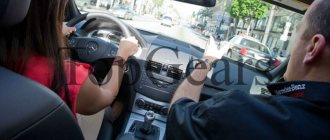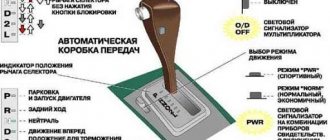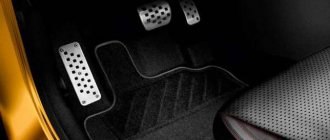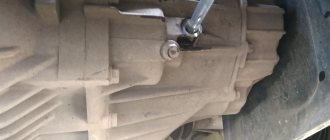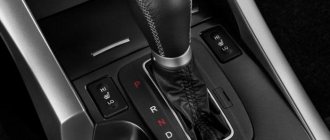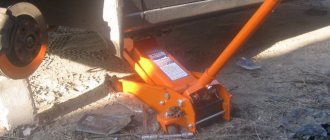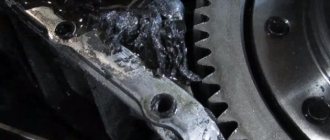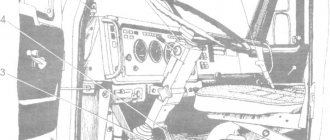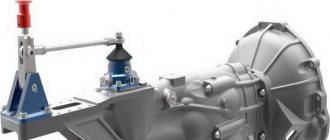Many novice drivers are interested in the question of how to instantly accelerate with a manual transmission. A quick start for a car depends, first of all, on the skills and knowledge of the driver, the preparedness of the car and the type of drive of the car. One of the most important rules for instant starting from a standing start is This is acceleration with minimal wheel slip. It should be noted that there are special racing tires called slicks. They have virtually no tread. For an effective start on such tires, a small amount of slip, around 20%, is recommended.
Quick start for a car on hard surfaces
1. Engage first gear
2. Raise engine speed to maximum torque. Usually this is 3000-4000 rpm. You need to learn to listen to them by ear, and not look at the tachometer. To do this, you need to practice this technique. First look at the tachometer and at the same time listen to the engine. It makes different sounds at different speeds.
This skill is needed to instantly accelerate, since at the start you will only need to look at the traffic light or, if it is drag racing, then at the go-ahead signal.
3. Release the clutch pedal to the initial connection - when the car “tensions” a little to move. This is done so that when starting off, the clutch can be engaged immediately, since it takes more time to release it from the initial position.
Also, to hold the car in place, a handbrake is used, which allows the clutch to be connected even better, thereby accelerating acceleration.
4. This stage is the most important and difficult - the initial movement. A quick start for a vehicle depends on the coordination of all actions. The most important thing is that wheel slip should be minimal. This moment needs to be worked out carefully until it is completely automatic, since when accelerating from a standstill in racing, the driver’s stress is high and you can easily make a mistake and lose the start.
At this stage, you should practice the speed of releasing the clutch pedal and further adding gas. You need to find a balance between them so that the wheels do not slip too much.
5. After the start, for maximum acceleration, the engine spins up to the red zone . At higher levels, in city cars, it is impossible to spin up the engine, since they have a cut-off (limiter) installed to preserve the “heart” of the car. On sports cars, the cut-off is removed, and it can be spun higher than it.
Electronic assistants
On-board computers of modern cars, as well as new devices and gadgets on the market, offer solutions for driving in reverse. The most popular include:
- Night vision system.
Thanks to the introduction of technology into the automotive industry, reversing has become much easier and safer. A set of infrared sensors scans the space around the car and, if necessary, signals the driver about the appearance of an obstacle on the way.
- All-round view.
The system records the space around the car and transmits a digital image model with a top view. It will be especially convenient for novice drivers.
Digital rear view mirror with camera image playback function.
The system consists of a rear-mounted camera and a screen that replaces the rearview mirror. The advantages of using this technology include a wide viewing angle, a clear image, the absence of obstacles such as rear row seats, and an improved image in low light conditions.
- Automatic brake.
Such a system blocks the wheels when an obstacle suddenly appears. Recommended for beginners and inexperienced drivers.
Torque and power, general concepts
It should be noted that the engine has two important indicators - power and torque. Torque is the thrust of the motor and is measured in Nm or Kgm. The average torque for naturally aspirated units with a volume of 1.4 - 1.6 is in the region of 12 - 16 Kgm (120 - 160 Nm), which is achieved at certain speeds. This means that to spin the drive wheels, a force of 12–16 kg is applied to a 1 meter long lever. It is thanks to the torque that the car accelerates. From engine power
Hello dear blog readers. I’m starting right away, so the main mistake is slipping of the drive wheels.
If on any surface, be it asphalt or ice, you do not allow slipping, then consider that you already have a piece of skill.
How to learn this? On a flat road, preferably in an unloaded car with a manual transmission, at idle engine speed, engage 1st gear and start the first movement without pressing the accelerator pedal at all, i.e. using only the clutch pedal. When the car starts to idle, stop it by “pressing the clutch” and repeat again.
Is it working out? Try the same thing, but using 2nd gear. Do not overdo it! It worked two or three times – that’s enough! With this start of movement, your drive wheels will not slip - there will not be enough engine power and, in extreme cases, it will simply stall. In ordinary life, of course, we won’t start moving like this, except in rare cases when it’s very slippery.
The conclusion is simple: the lower the engine speed when starting to move, the greater the likelihood that there will be no slipping! To make it easier for the car to start moving, the front wheels must be set strictly straight!
The start of movement or “acceleration”, to put it simply. Many will even name the necessary components - weather-appropriate tires, a powerful engine - and they will be right, but only partly.
What else is important to know, and most importantly, to be able to do? that the main mistake is, firstly, the drive wheels of your car slipping in place. Secondly, the car is not located straight in relation to the direction of movement, and the front wheels are turned (not strictly straight).
How to learn to feel the beginning of slipping? A simple exercise, starting the movement without “gas”, we think, did not cause any great difficulties.
Lesson two. Subtle sensations. The car is standing on level ground with the engine running. Engage I gear and begin to slowly release the clutch pedal. There will come a time when your car, before starting to move, will seem to “stress.” Pay attention to this, you should try to feel it!
After the moment of “tension”, if you release the clutch a little more, the movement will begin. But, as soon as the car makes an impulse to move and the wheels turn slightly, press the clutch just enough so that it stops and the “tension” is eliminated. Doing this non-stop will cause the car to rock in place. The smaller the amplitude, the better! Ideally, the tires stay in place, and the wheel rim barely turns back and forth. The exercise can be performed at any time and anywhere, it is absolutely safe. Now you know exactly how your clutch works and in what range. By the way, all of the above can be done in a car with automatic transmission. The next stage of training and sensations.
The car is standing still, you increase the engine speed to any value (for example, 2,500 rpm) and hold it for a long time. It is better to do this by looking at the device - a tachometer, if there is one, and if not, then by ear. Your task is to engage I-gear and start moving, maintaining the engine speed that you set before. From the beginning to the end of the exercise, the speed is the same - it does not fall or rise.
It is better to do this on an area where there is no traffic of cars and pedestrians. During your first attempts, it is better to look at the tachometer, again, if you have one. You need to start with a slight increase in speed and, as you progress, complicate the task by increasing it. It is important to pay attention to the speed at which the clutch pedal is released, namely: try to do this as quickly as possible.
If everything is done absolutely correctly, then the car accelerates quickly and without slipping, and the higher the engine speed that you hold, the faster. There comes a time when execution becomes impossible due to slippage. Most often, this means that for a given road surface you have crossed the limit of what is permitted and the engine speed is too high.
The conclusion is simple: the higher the coefficient of adhesion, the higher the speed for fast acceleration we can afford! By accelerating in this way, you begin to detect the beginning of slipping, if you make a mistake - this is the uniqueness of the exercise. Tricks of acceleration and starting movement.
1. If you need to win the “start”, then the maximum form of your readiness for this is when the engine speed is selected correctly, the front wheels are straight, and the car is barely noticeably swaying on the spot;
2. When starting to move, the vehicle's center of gravity moves rearward, loading the rear wheels. If the car has rear-wheel drive, this increases the acceleration efficiency, and if it has front-wheel drive, it reduces it (the front, driving wheels are loaded).
Using the technique of rocking in place, i.e. By moving the car back and forth, you also move the center of gravity back and forth. By taking advantage of its movement (depending on the type of drive of your car), you can increase the efficiency of the starting moment, and even on a very slippery road you can start moving without slipping.
Advice: If you start a race on some track, it is advisable to make a few jerks to check the effectiveness of the grip, because not all roads are the same.
How to drive a manual car
When you get behind the wheel for the first time, even a confident person gets nervous. Therefore, it is important to know theoretically how to properly learn to drive a manual car. Then the instructor’s explanations will not seem like something supernatural. We'll talk about how to learn to drive a manual car and study all the stages of driving and braking.
Important Notes
Before you get behind the wheel, you need to study the structure of the car, the traffic rules, and find out where the controls are located. Information about possible malfunctions and rules for providing first aid will not be superfluous. Anything can happen on the road. After studying the topic of driving, you can begin practical lessons.
How to drive a manual transmission.
In America, the share of new cars sold with a manual transmission is only 6 percent. Therefore, many American drivers find driving a car with a manual transmission very difficult. So many drivers are accustomed to driving vehicles with automatic transmission. In our country, the share of cars sold with a manual transmission is still slightly larger than with an automatic transmission, but, nevertheless, driving a car with a manual transmission causes a lot of difficulties for many drivers. Our online publication has prepared instructions and a small guide for all car enthusiasts that will help you learn how to drive a manual car.
Cars with manual transmissions tend to cost less than cars with automatic transmissions. But driving a vehicle with a manual transmission will not only allow you to save money when buying a car, but will also open up a whole new world of driving for you.
Note that many powerful sports cars are still equipped with a manual transmission. But even if you buy an inexpensive, weak car, it will allow you to significantly reduce fuel costs, since a car equipped with a manual transmission consumes much less fuel than a car equipped with an automatic transmission.
What other advantages do manual transmissions have over automatic transmissions? A manual transmission is much more reliable than an automatic transmission, and besides, the cost of repairing a manual transmission is much less than repairing a complex automatic transmission.
Plus, driving a car with a manual transmission in winter is much safer than driving a car with an automatic transmission.
How to start a car correctly in winter
For novice drivers, driving a car with an automatic transmission
Not only do you just need to know how to start a car, you also need to know how to start a car correctly in winter. Usually problems with this matter begin when the outside temperature is about 15 and below. The very first problem that may arise is that you will not be able to get into the car, because... his windows and doors were frozen. Read what to do in this situation here: “Doors and windows are frozen - what to do?”
You literally need to know step by step what to do in such a situation.
We make sure that the radio, heater fan, heated seats and windows are turned off. All these devices are unnecessary battery consumers. At this stage, you need to let the battery warm up. To do this, you can turn on the high beam for about 30 seconds or the low beam for about 2 minutes (this recommendation is relevant for older cars)
If you have doubts about your car battery, you can repeat these steps several times. We press the pedal responsible for the clutch several times, taking into account that this is done on a car with a manual transmission (manual transmission). On injection cars, you cannot touch the gas pedal until the car is started.
After the engine starts running, you should not suddenly release the clutch pedal, but rather release it gradually. We start the engine. If you cannot start the engine 2 or 3 times in a row, you just need to wait a while - about 1.2 minutes.
See how to properly start a car in severe frost:
Starting a diesel car in winter
Glow plug indicator
It is especially difficult for a diesel engine to start in winter due to waxing of the fuel
In cold weather, you should only refuel with winter diesel fuel - pay attention when refueling! Diesel engines are equipped with glow plugs
They heat the fuel, making it easier to start the engine. Therefore, before starting, turn on the ignition and wait until the glow plug indicator goes out. In severe frost, you can let the indicator go out several times and only then start
Diesel engines are equipped with glow plugs. They heat the fuel, making it easier to start the engine. Therefore, before starting, turn on the ignition and wait until the glow plug indicator goes out. In severe frost, you can let the indicator go out several times and only then start.
If it still doesn’t start and you are sure that the problem is definitely not in the battery (by the way, to be sure, read how to choose the right battery) - it means that the diesel fuel has frozen.
The simplest thing you can do in this situation is to drive the car into a heated garage (yours, a friend’s, or an indoor one at a shopping center) for several hours.
If this is not possible, then you just need to warm it up in the area of the oil and fuel filter. To do this, there must be access to the bottom of the car: i.e. either lift it with a jack, or use a trestle, pit or lift. A blowtorch is usually used as a heat source, you can try a home or hair dryer (you need a source of electricity.) Then try to start the car again.
Step one: Why are gears needed in a manual transmission?
A manual transmission requires the driver to change gears independently. Most manual transmission cars have 4 or 5 speeds plus one reverse gear. In order to master where what gear speed is and what each of them is needed for, you need to know the following:
Clutch pedal. When you press the pedal, a special mechanism in the box allows you to use the gear shift knob to engage the desired gear. Remember that you can only shift the gearbox if the clutch pedal is pressed all the way down.
Neutral actually means that no torque from the engine will be transmitted to the wheels. With the engine running and neutral gear engaged, if you press the gas pedal, the car will not move. When neutral gear is engaged, you can engage any speed from this position, including reverse gear.
For most manual cars, 2nd gear is the workhorse, as first gear is primarily used for starting. Second gear will help you drive your car down a steep slope or help you navigate through traffic jams.
Reverse gear is slightly different from other speeds in a manual transmission. This speed received a slightly larger range of operation than first gear. In reverse you can accelerate faster than in 1st. But reverse gear does not “like” when the car drives in this mode for a very long time (it can lead to failure of the gearbox mechanism).
So reverse gear is not the main way to move.
The accelerator pedal allows you to use the maximum engine torque set for each speed at each speed. When accelerating in a car equipped with a manual transmission, you feel every speed, which gives every driver a unique feeling of drive and better control over the car.
Learning to drive a car with a manual transmission
After the driver's seat has been prepared (the driver's seat, side mirrors and rearview mirror have been adjusted), you can begin to familiarize yourself with the pedal assembly.
A manual car is equipped with three pedals: clutch, brake and accelerator (gas). The clutch pedal is located on the left, the brake pedal is in the middle, and the accelerator pedal is on the right.
- The clutch pedal is designed to transmit torque and smooth gear changes. Moreover, you can change gears only with the clutch pedal depressed. The driver depresses the clutch pedal with a quick press and releases it smoothly, taking into account the free movement of the clutch until the clutch disc contacts the engine flywheel and the vehicle begins to move. After the car has started moving, you need to gradually press the accelerator pedal and remove your foot from the clutch pedal.
- The brake pedal is pressed with the right foot and serves to slow down the car. The force of pressing the brake pedal primarily depends on the speed and road conditions. The lower the speed, the less effort.
- Accelerator pedal. Using the accelerator pedal, the driver changes the amount of fuel mixture entering the internal combustion engine cylinders, thereby increasing or decreasing the crankshaft rotation speed.
Accordingly, the speed of the vehicle changes. The harder the driver presses the accelerator pedal, the more fuel mixture enters the engine cylinders, and the power indicators of the internal combustion engine increase.
A novice driver must remember that when driving a car equipped with a manual transmission, the right foot moves from the gas pedal to the brake pedal and vice versa, and the left foot works only with the clutch pedal. An exception is the use of sports control techniques, when braking can be performed by a professional with the left foot.
The gear shift lever is designed to change manual transmission gears while the vehicle is moving. Each manual transmission stage corresponds to a specific speed limit. When the speed increases, the driver needs to engage an upshift, and when the speed decreases, accordingly, engage a downshift.
How to drive a manual car: step-by-step instructions
- We take the correct position behind the wheel of the car, check the position of the lever (it must be moved to neutral).
- Turn the key in the ignition and start the car engine.
- Next, press the brake with your right foot, depress the clutch pedal with your left foot and engage first gear.
- Then release the brake, place your right foot on the gas and at the same time smoothly release the clutch pedal.
- After the car moves slightly, we dose the traction with the accelerator pedal until the car begins to move confidently.
- After the car starts to move, completely remove your foot from the clutch pedal and continue to press the accelerator pedal to further increase the speed of the car.
- When you reach the required speed limit recommended for driving the car in first gear, release the gas, depress the clutch again and engage second gear. In this case, the clutch can be released a little more sharply than when starting in first.
- If you select the right gear correctly, the box will shift without jolts or jerks.
Recommended speed limits in different gears:
- first gear 0-20 kilometers per hour;
- second gear 20-40 kilometers per hour;
- third gear 40-60 kilometers per hour;
- fourth gear 60-90 kilometers per hour;
- fifth gear 90-110 kilometers per hour;
- sixth gear over 110 kilometers per hour.
Driving a car with a manual transmission: braking
When smoothly braking or braking, the driver must move his right foot from the gas pedal to the brake pedal, ensuring that the vehicle speed decreases to the required level.
After which, if there is no need to completely stop the car, the driver must depress the clutch, engage the gear corresponding to the given speed limit and continue driving.
Step Five: Coordinated Action
What is a gear shift knob? This is your door to the world of drive, acceleration and a special perception of the car. But in order to fully experience the true pleasure of driving a manual car, well-coordinated actions are required. As an example for the 1st and 2nd speeds, we will give all your actions that over time you should bring to automaticity.
Depress the clutch pedal all the way. Switch the gear knob to first speed. Begin to slowly release the clutch pedal while simultaneously pressing the gas pedal smoothly and slowly. Having brought the clutch pedal somewhere to the middle, you will feel that the torque has begun to be fully transmitted to the wheels. Smoothly releasing the clutch pedal all the way, accelerate to 25 km/h. Next you need to switch to second gear. To do this, again depress the clutch completely and shift the speed to second gear, then smoothly, lowering the clutch pedal, slowly increase the gas.
Acceleration is not possible
The driver can use the brakes or turn the steering wheel at any time. But to speed up (often you need to speed up to avoid an accident) will no longer work, because you need to engage the gear and press the gas pedal to the floor, and this is a waste of precious time, when not even a second, but a fraction of a second matters.
As a result, neutral gear does not allow you to use all three methods in order to avoid an accident. This may be tantamount to the fact that the car simply does not have a brake pedal or steering wheel. This way, it will probably be clearer for those drivers who want to travel as safely as possible.
How to start a car manually
From this article you can learn how to start a car manually . It is very useful and the owner of a vehicle can learn about a number of features.
Those who recently studied at a driving school to get a license were faced with the practice of driving around the city. This is where most instructors teach to push from a standstill using only one clutch.
However, this is not always sufficient. Currently, there are many videos on the World Wide Web, during viewing of which it becomes clear how to start a car with a mechanic, step-by-step instructions .
To get a more accessible video or instruction on the Internet, it is recommended to search for how to start a car manually for dummies . It is then that a huge list will open, where each clip will explain in detail how to start the car to a mechanic in the form of step-by-step instructions.
